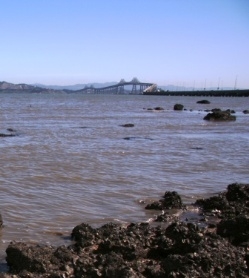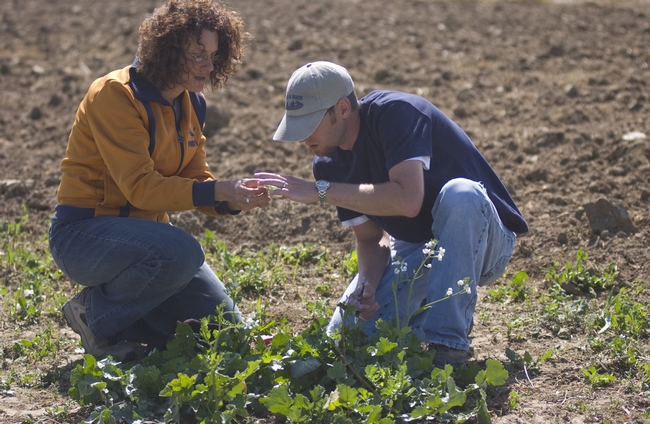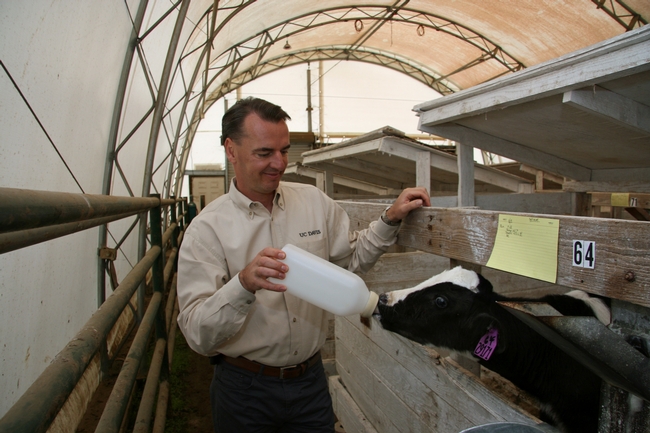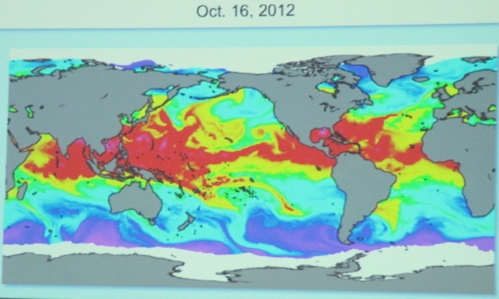Posts Tagged: global warming
Bodega Marine Lab keeps watch on ocean temperatures
Ocean waters are warming, sea level is rising, seawater is becoming more acidic, and shoreline erosion is intensifying. The world’s oceans are reacting to increased carbon dioxide and other greenhouse gases in the earth’s atmosphere.
“The physical and chemical environment of the ocean is changing with the climate,” said John Largier of the UC Davis Bodega Marine Laboratory. “This affects ecosystems — like tidal marshes and coral reefs that protect us from storms and flooding.”
The ocean brings stability to the earth’s climate. It heats up and cools down more slowly than the land and the air. With climate change, the ocean absorbs excess heat trapped in the earth’s system by the increased concentration of gases in the atmosphere.
As seawater warms, it expands. The increase in the ocean’s heat content has contributed to one of the most visible effects of global warming — rising sea level. Thermal expansion, along with melting polar ice caps and glaciers, has led to global sea level rise of more than seven inches over the last century.
“When the ocean begins to warm up, then you know that the earth’s climate is changing,” said Largier, a professor in the Department of Environmental Science and Policy. “Even if we stop putting greenhouse gases into the atmosphere right now, the ocean has warmed up, and it will take centuries for it to cool down. People don’t realize that we’ve already made a long-term commitment to climate change.”
At the Bodega Marine Lab, Largier and other scientists are studying the regional impacts of climate change on the waters off California, which include an increase in coastal upwelling. Driven by winds, upwelling pulls cold water and nutrients from the ocean depths to the surface along the shore and contributes to the “marine layer,” the blanket of cool moist air that moderates California temperatures. Largier’s research shows a trend toward stronger winds and an increase in upwelling since 1982, leading to cooler waters off central and northern California.
“Worldwide, the ocean’s surface water is getting warmer, but in California, the ocean is getting colder near shore,” said Largier. “This is intriguing because it shows that climate change is not going to have the same effect everywhere. There will be regional differences.”
This article was condensed slightly from UC Davis “CA&ES Outlook” magazine. Read the full article on page 7.
Read John Largier's scientific advisory group report on how changes in the ocean might affect two valuable marine sanctuaries off the northern California coast: "Climate Change Impacts: Gulf of the Farallones and Cordell Bank National Marine Sanctuaries"
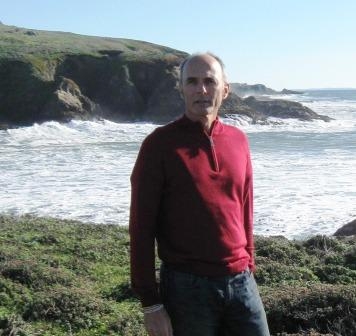
John Largier along the northern California coast. (Photo: Jennifer Sauter/UC Davis)
Weather changes, global warming doesn’t
The first thing I had to learn as writing staff at the John Muir Institute for the Environment, UC Davis, was the difference between "climate" and "weather." I compare it to reading a stock chart, there are jagged peaks and valleys daily, but it takes stock performance over years to reveal an unmistakable trend. The small ticks are similar to weather but the trend over decades is closer to climate. Nearly every stock chart has a huge valley at the year 2008, this is thought to be a once in a century event. That event is analogous to climate change, except climate trends are measured over millions of years, and climate is thought to be much slower to recover.
American opinions about global warming are as uncertain as the stock market and as changeable as the weather, according to The Center for Climate Communications at George Mason University in Fairfax, Virginia. The center just released the results of their second survey entitled, "Climate Change in the American Mind: Americans' Global Warming Beliefs and Attitudes in April 2013."
Highlights include:
- Nearly two in three Americans (63%) believe global warming is happening. Relatively few - only 16 percent - believe it is not.
- Of the 63% who believe global warming is happening most say they are "very" (33%) or "extremely sure" (27%). By contrast, of the unconvinced, fewer are very (28%) or extremely sure of their view (18%).
- About half of Americans (49%) believe global warming - if it is happening - is caused mostly by human activities, a decrease of 5 points since fall 2012, but similar to levels stretching back several years.
- More Americans believe that "most scientists think global warming is happening" (42%) than believe there is widespread disagreement among scientists (33%).
- At least four out of ten Americans say global warming will harm people in their community (45%), their family (44%), or themselves (42%).
I had the privilege to acquire my understanding of climate by listening to the top researchers in the field, and writing about their discoveries. Without that opportunity, I might easily have been a skeptic since that is closer to my nature.
Climate science is seriously underrated by the public and even by scientists outside the field. Climate studies are complex, requiring knowledge from multiple disciplines ranging from geology, to physical chemistry and ecology. Forget Doppler radar and weather balloons. When an acquaintance stated unequivocally that climate science is not "real science," it was his lack of appreciation for climate science that was talking as well as his nature. His Ph.D. in chemistry, earned decades ago, had not yet revealed the role of chemistry in predicting climate. Historical evidence has been collected from stalactites, ocean sediments and ice cores, some of which were formed while Neanderthals and Homo sapiens were competing for caves.
What we learned about the carbon cycle in high school earth science has been long forgotten. Ask the average scientist to expound on the carbon cycle, their eyes glaze over on the connections between oceans, the atmosphere and the soils. They are focused on more immediate threats, such as the complex relationship between inflammation and the formation of plaque in their arteries.
Now that the atmosphere is estimated to contain 400 parts per million of carbon dioxide, perhaps the next species of man, Homo climatcans, will learn to act on the science that the majority of us have yet to discover.
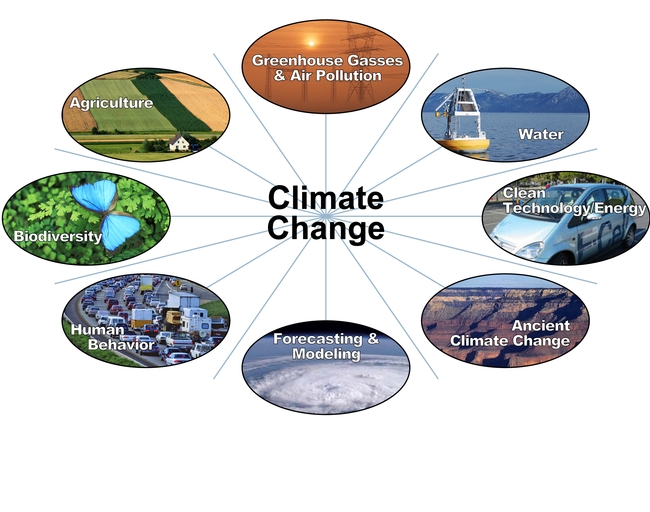
ClimateChange
Feeding billions in the face of climate change
As drought dries the landscape and rising global temperatures make for decreasing crop yields, farmers are faced with the question of how to feed billions of people in a way that both reduces global greenhouse gas emissions and adapts to the realities of climate change.
Scientists and policymakers from around the world will gather today through Friday, March 20-22, at the University of California, Davis, to grapple with the threats of climate change for global agriculture and recommend science-based actions to slow its effects while meeting the world's need for food, livelihood and sustainability.
The Climate-Smart Agriculture Global Science Conference, planned in coordination with the World Bank, builds on a 2011 international meeting on this theme in the Netherlands.
"Climate change, which brings severe weather events and more subtle but equally menacing temperature changes, presents unprecedented challenges to the global community," said UC Davis Chancellor Linda P.B. Katehi.
"In California, where we rely heavily on snowmelt for irrigation to grow half of our nation's fruit and vegetables, we are acutely aware that scientists and policymakers must join forces to lessen the potential effects of climate change," she said.
Katehi will open the conference on Wednesday, March 20, along with Thomas Vilsack, secretary of the U.S. Department of Agriculture (via video). The public is invited to attend the opening day’s program (8:45 a.m.-12:30 p.m), free of charge; and the closing day’s afternoon program (noon-3:45 p.m.), also free of charge. These will be held in Jackson Hall of the Mondavi Center for the Performing Arts. (Lunches not included.)
Catherine Woteki, USDA undersecretary, will speak Thursday evening, March 21.
Other speakers will include: Ben Santer, climate researcher at Lawrence Livermore National Laboratory and a member of the National Academy of Sciences; Joseph Alcamo, chief scientist for the United Nations Environmental Program; and Patrick Caron, general director for research and strategy of the French Agricultural Research Center for International Development. Also speaking will be outstanding scientists from dozens of universities and research institutes from around the world.
Conference topics will focus on the implications of cutting-edge agricultural, ecological and environmental research for improved design of policies and actions affecting agricultural management and development; identifying farm and food-system issues, determining research gaps; highlighting emerging research initiatives; and developing transformative policies and institutions.
The conference will conclude with participants developing and endorsing a declaration regarding the key research and policy messages that result from conference presentations and discussions. This declaration is expected to point toward science-based policies and actions for global agriculture that will mitigate climate change and encourage adaptation to maintain food security, livelihoods and biodiversity.
UC Davis scientist to lead UN effort to study livestock’s environmental impact
In the aftermath of Hurricane Sandy, climate change and global greenhouse emissions are a hot topic these days. Dozens of UC Davis scientists study many facets of the causes and consequences of global warming.
One of them is Frank Mitloehner, UC Cooperative Extension specialist and professor in the Department of Animal Science at UC Davis. Mitloehner has studied the role of the livestock industry in contributing to greenhouse gas emissions. Mitloehner was recently selected to chair a United Nations committee to measure and assess the environmental impacts of the livestock industry.
As chair of the new Food and Agriculture Organization of the United Nations (FAO) committee, he will lead representatives of national governments, livestock industries, nonprofits, and the private sector in establishing science-based methods to quantify livestock’s carbon footprint, create a database of greenhouse gas emission factors for animal feed, and develop a methodology to measure other environmental pressures, such as water consumption and nutrient loss.
“By the end of three years, we’ll have a methodology that’s globally accepted, that anyone in the world can use to quantify the environmental impact of their livestock,” Mitloehner said.
The FAO estimates that meat consumption will increase 73 percent by 2050 and dairy consumption will grow 58 percent over current levels. Methods of raising livestock differ throughout the world, with American producers being among the world’s most efficient. For instance, it takes approximately 20 Indian cows to produce as much milk as one dairy cow in the United States.
Mitloehner’ s research has found that livestock account for 3.4 percent of greenhouse gas emissions in the United States. The transportation sector, on the other hand, contributes roughly 26 percent.
“Transportation choices continue to be the main contribution to climate change and not, as is often depicted, food choices,” Mitloehner says. “This new program is an effort to harmonize methodologies to benchmark the environmental impact of livestock.”
Among the founding members of the committee are the governments of France, Ireland, the Netherlands, and New Zealand, as well as the European Feed Manufacturers’ Federation, the European Vegetable Oils and Proteinmeal Industry, the International Dairy Federation, the International Meat Secretariat, the International Egg Commission, the International Poultry Council, the International Federation for Animal Health, and the World Wildlife Fund.
Climate is indeed an angry beast
Global warming promises to be among the most immense challenges to human adaptation in history, as big as social media. But the climate topic has been overshadowed in recent years by the recession. Just as the Dow Jones can’t be described by the fluctuations of a single decade, climate science is not defined by periods less than centuries.
These thoughts were shared at a breakfast Oct. 16 at UC Davis hosted by Capital Public Radio. The speaker: Ben Santer, MacArthur Fellow (1998), National Academy Member (2012), and atmospheric scientist at Lawrence Livermore National Laboratory.
Santer said that when he hears about the tragedy of burdening youth with the national debt, he would like to hear more about the burdening of youth with global climate change. The verbal references have vaporized.
It was appropriate that Santer opened his talk with a graphic depicting changes in global water vapor, the greenhouse gas that Earth relies on to sustain its water cycles. This greenhouse gas inspired 10,000 years of human supplication to climate gods that could meet their need for rain. But he didn’t come to talk about the largely unpredictable weather (he calls this noise), except as an indicator of a more predictable long-term climate trend (he calls this the signal). Scientists have methods to work out the signal to noise ratio and finding the major trends among frequent short-term fluctuations.
Santer has been involved with the IPCC since 1990. It wasn’t until 1995 that this international mouthpiece of global climate science announced that the evidence suggested that there was a human influence on global climate.
To his surprise, Santer spent the next year and a half defending that cautionary statement, and his research role turned into that of a messenger. Two more IPCC reports and 17 years later, he is still confirming human influences through testimony to the U.S. House of Representatives’ Committee on Global Warming (2010). His message remains the same, “Climate science is not a scam, a hoax, or a conspiracy.” It is not a belief system, so he doesn’t have to “believe in it.” He does believe in scientific facts, and proving hypotheses. His graphics make a strong case for the science, but his research problem is one of communication. He resolved to talk to everyone he meets about it.
His advice, when asked this question from the audience, would be to make the U.S. a leader in solutions rather than a leader in finger pointing. He believes that the leaders who make economic decisions based on climate science will be better able to adapt and manage the impending change, however placing blame on other nations is counterproductive to this goal.
What can we expect from the next IPCC global climate report? Santer predicts that there will be a downsizing of scale to regional scenarios. Following sage advice, if the problem is too big, break it down. His last word, a quote from climate scientist Wally Broecker, “Climate is an angry beast and we are poking it with a sharp stick.”

